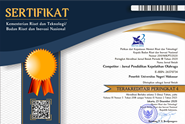Measurement of Medial Head Gastrocnemius Muscle Contraction Strength in Basic Sepak Takraw Techniques Using Electromyogram Signals
(1) Department of Sport Science and Health, Universitas Negeri Makassar
(2) Department of Sport Science and Health, Universitas Negeri Makassar
(3) Department of Sport Science and Health, Universitas Negeri Makassar
(4) Department of Sport Science and Health, Universitas Negeri Makassar
(5) Department of Sport Science and Health, Universitas Negeri Makassar
(*) Corresponding Author
DOI: https://doi.org/10.26858/cjpko.v15i3.53403
Abstract
Keywords
Full Text:
PDFReferences
D. Bakti Saputro, (2017). “Pengembangan Variasi Latihan Sepak Sila Sepak Takraw Untuk Tingkat Pemula,” IPJ, vol. 1, no. 2, 2017, [Online]. Available: http://journal2.um.ac.id/index.php/jko
Eleanor Criswell, (2011). “Cram’s introduction to Surface Electromyography.,” 2nd ed., Jones and Bartlett Publishers, 2011, pp. 35–65.
F. D. Farfán, J. C. Politti, and C. J. Felice, (2010). “Evaluation of EMG processing techniques using Information Theory,” Biomed Eng Online, vol. 9, no. 1, p. 72, 2010, doi: 10.1186/1475-925X-9-72.
G. Kamen and G. E. Caldwell, (1996). “Physiology and Interpretation of the Electromyogram,” Journal of Clinical Neurophysiology, vol. 13, no. 5, pp. 366–384, Sep. 1996, doi: 10.1097/00004691-199609000-00002.
H. D. Dave, M. Shook, and M. Varacallo, (2023). Anatomy, Skeletal Muscle.
H. L. Sweeney and D. W. Hammers, (2018). “Muscle Contraction,” Cold Spring Harb Perspect Biol, vol. 10, no. 2, p. a023200, Feb. 2018, doi: 10.1101/cshperspect.a023200.
I. Iyakrus and A. Ramadhan, (2021). “Tingkat keterampilan sepak sila pada permainan sepak takraw,” Altius: Jurnal Ilmu Olahraga dan Kesehatan, vol. 10, no. 2, pp. 225–230, Nov. 2021, doi: 10.36706/altius.v10i2.15154.
Imamal Muttaqien, Nurul Subkhi, Aceng Sambas, and Mada Sanjaya, (2016). “Desain dan Analisis Electromyography (EMG) Seta Aplikasinya dalam Mendeteksi Sinyal Otot,” ALHAZEN Journal of Physics, vol. 2, no. 2, 2016.
J. P. Ahtiainen and K. Häkkinen, (2009). “Strength Athletes Are Capable to Produce Greater Muscle Activation and Neural Fatigue During High-Intensity Resistance Exercise Than Nonathletes,” J Strength Cond Res, vol. 23, no. 4, pp. 1129–1134, Jul. 2009, doi: 10.1519/JSC.0b013e3181aa1b72.
J. Sun, G. Liu, Y. Sun, K. Lin, Z. Zhou, and J. Cai, (2022). “Application of Surface Electromyography in Exercise Fatigue: A Review,” Front Syst Neurosci, vol. 16, Aug. 2022, doi: 10.3389/fnsys.2022.893275.
K. Udomtaku and K. Konharn, (2020). “Energy expenditure and movement activity analysis of sepaktakraw players in the Thailand league,” J Exerc Sci Fit, vol. 18, no. 3, pp. 136–141, Sep. 2020, doi: 10.1016/j.jesf.2020.04.001.
M. B. I. Reaz, M. S. Hussain, and F. Mohd-Yasin, (2006). “Techniques of EMG signal analysis: detection, processing, classification and applications,” Biol Proced Online, vol. 8, no. 1, pp. 11–35, Dec. 2006, doi: 10.1251/bpo115.
M. Del Olmo and R. Domingo, (2020). “EMG Characterization and Processing in Production Engineering,” Materials, vol. 13, no. 24, p. 5815, Dec. 2020, doi: 10.3390/ma13245815.
M. N. Jawis, R. Singh, H. J. Singh, and M. N. Yassin, (2005). “Anthropometric and physiological profiles of sepak takraw players,” Br J Sports Med, vol. 39, no. 11, pp. 825–829, Nov. 2005, doi: 10.1136/bjsm.2004.016915.
N. J. Campbell and C. V. Maani, (2023). Histology, Muscle.
S. Pham and Y. Puckett, (2023). Physiology, Skeletal Muscle Contraction.
S. Fukuhara, T. Kawashima, and H. Oka, (2021). “Indices reflecting muscle contraction performance during exercise based on a combined electromyography and mechanomyography approach,” Sci Rep, vol. 11, no. 1, p. 21208, Oct. 2021, doi: 10.1038/s41598-021-00671-2.
S. E. Nishi, R. Basri, and M. K. Alam, (2016). “Uses of electromyography in dentistry: An overview with meta-analysis,” Eur J Dent, vol. 10, no. 03, pp. 419–425, Jul. 2016, doi: 10.4103/1305-7456.184156.
T. J. Roberts and A. M. Gabaldon, (2008). “Interpreting muscle function from EMG: lessons learned from direct measurements of muscle force,” Integr Comp Biol, vol. 48, no. 2, pp. 312–320, Jun. 2008, doi: 10.1093/icb/icn056.
T. Klotz, L. Gizzi, U. Ş. Yavuz, and O. Röhrle, (2020). “Modelling the electrical activity of skeletal muscle tissue using a multi-domain approach,” Biomech Model Mechanobiol, vol. 19, no. 1, pp. 335–349, Feb. 2020, doi: 10.1007/s10237-019-01214-5.
T. Triwiyanto, T. Rahmawati, P. Alit Pawana, E. Evrinka, and H. Maulidia, (2022). “Investigation of Electrode Location to Improve the Accuracy of Wearable Hand Exoskeleton Trainer Based on Electromyography,” 2022. [Online]. Available: www.scientific.net.
V. Gohel and N. Mehendale, (2020). “Review on electromyography signal acquisition and processing,” Biophys Rev, vol. 12, no. 6, pp. 1361–1367, Dec. 2020, doi: 10.1007/s12551-020-00770-w.
W.-H. Tai, R. Zhang, and L. Zhao, (2023). “Cutting-Edge Research in Sports Biomechanics: From Basic Science to Applied Technology,” Bioengineering, vol. 10, no. 6, p. 668, Jun. 2023, doi: 10.3390/bioengineering10060668.
Article Metrics
Abstract view : 70 times | PDF view : 47 timesRefbacks
- There are currently no refbacks.
Copyright (c) 2023 Rusli ully Rusli

This work is licensed under a Creative Commons Attribution 4.0 International License.
COMPETITOR IS LICENSED BY :
 COMPETITOR is licensed under a Creative Commons Attribution 4.0 International License.
COMPETITOR is licensed under a Creative Commons Attribution 4.0 International License.
COMPETITOR EDITORIAL LOCATION :
![]() Kampus FIK Banta Bantaeng, Jalan Wijaya Kusuma Nomor 14, Rappocini, Makassar, Postal Code 90222
Kampus FIK Banta Bantaeng, Jalan Wijaya Kusuma Nomor 14, Rappocini, Makassar, Postal Code 90222
COMPETITOR IS INDEXED BY















